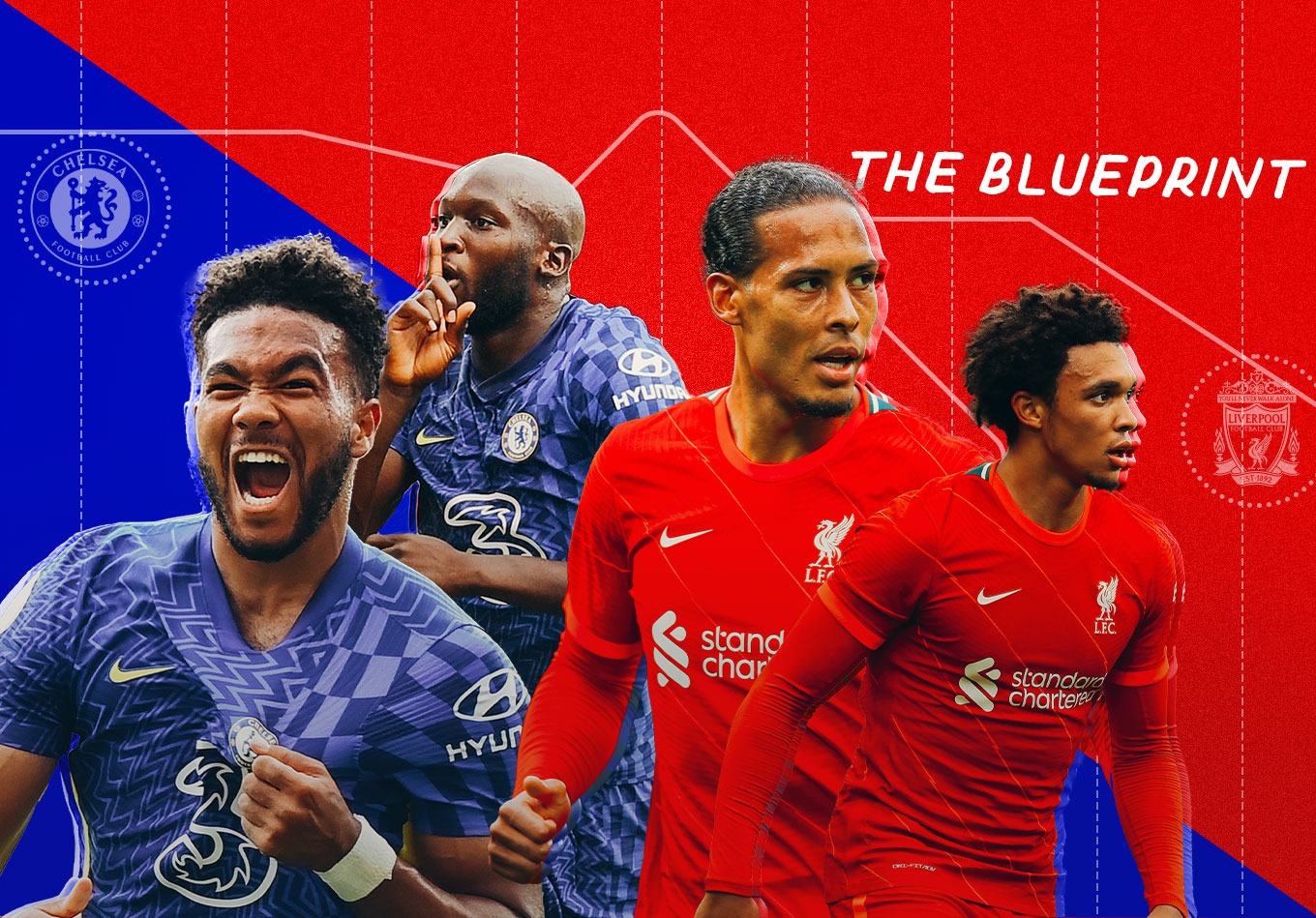Oh boy, now this should be good. Liverpool host Chelsea on Saturday in a mouth-watering encounter.
Everywhere you look, there are contests to savour. Jürgen Klopp against Thomas Tuchel. Yes please. Virgil van Dijk against Romelu Lukaku. Hell yeah. Mohamed Salah against Antonio Rüdiger. Different, but there’s a place for that.
Tuchel’s Chelsea march on. Their London derby win over Arsenal was brutally efficient, as they demonstrated their clear superiority in every single facet of the game. Since taking charge of Chelsea on Jan. 26, 2021, Tuchel’s picked up 44 points in 21 games (2.10 per game), with only Manchester City winning more (51) over that time period, with an extra game played.
Liverpool have continued where they finished last season. Klopp’s men have won each of their last seven Premier League games, as many victories as they enjoyed in their previous 20 games in the competition (D5 L8). It’s their longest winning streak in the league since that incredible run of 18 that came to an end in February 2020. With van Dijk restored in their defence, everything just feels so much better, and they are, once again, potential title winners.
But something’s got to give this weekend. Where might the keys to the game lie?
1. How the Hell Do You Defend Against Lukaku?
“There’s rarely a centre-half in the league that [can deal] with me. If I hold you like this, and I roll you like this… it’s finished.”
That’s Lukaku talking. He could’ve spoken those words after Sunday’s evisceration of poor Pablo Marí. Or numerous times during his rampant spell at Inter. But this was during a masterclass with Sky Sports in 2017, while the Belgian was at Everton. Four years later, those words could not be truer, that self-belief no more evident.
Let’s state the obvious. Lukaku was virtually unplayable at the Emirates and the focal point for every Chelsea attack. He attempted eight shots and created three chances. Only once before has the Belgian been involved in 11 or more of his sides’ shots in a Premier League match – for Everton versus West Ham in May 2015. If he performs like this regularly this season, then opposition defences ought to be very concerned.
But his dominant centre-forward display raises a pertinent question… how the hell do you defend against him? Central defenders are usually taught to get tight to their opposition strikers, to ‘let them know you’re there’. But as Marí showed on Sunday, the second you do that against a physical and technical striker like Lukaku, “it’s finished”. He’s too strong, too good with his back to goal. He’ll pin you and roll you all day.
We saw it for the opening goal. Mateo Kovačić rolls the ball into his feet and Marí is intent to stick tight to his man. We see Lukaku receiving side-on with the outstep of the leg furthest away.
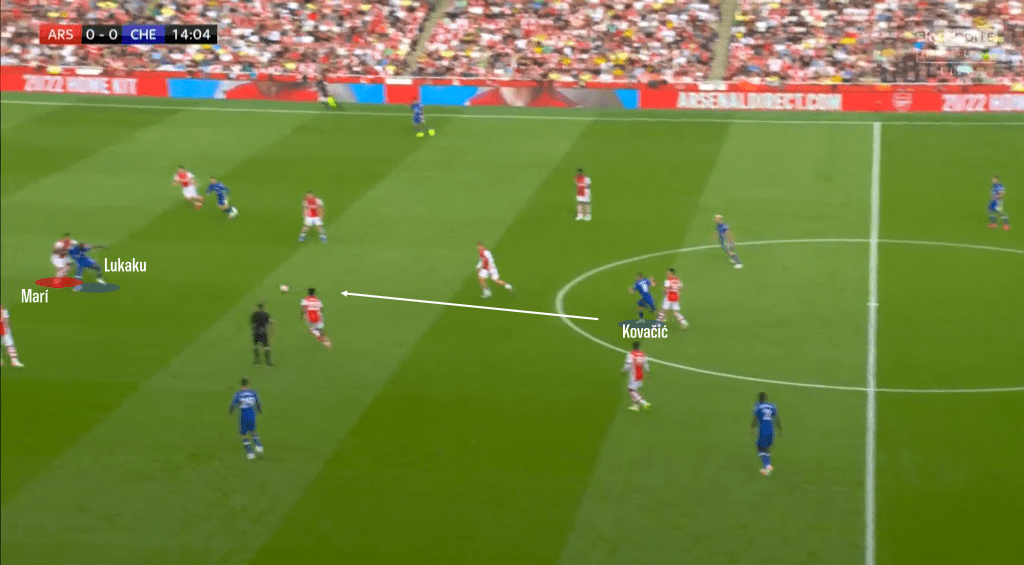
Lukaku is able to hold Marí off with ease as the defender fights for the ball.
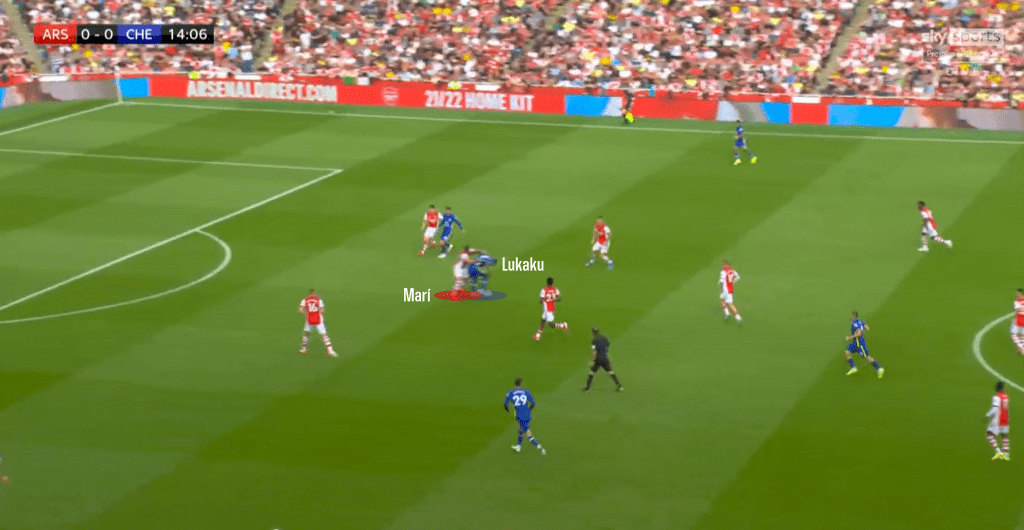
Lukaku then lays the ball back to Kovačić who spreads the play out to Reece James on the Chelsea right in acres of space.
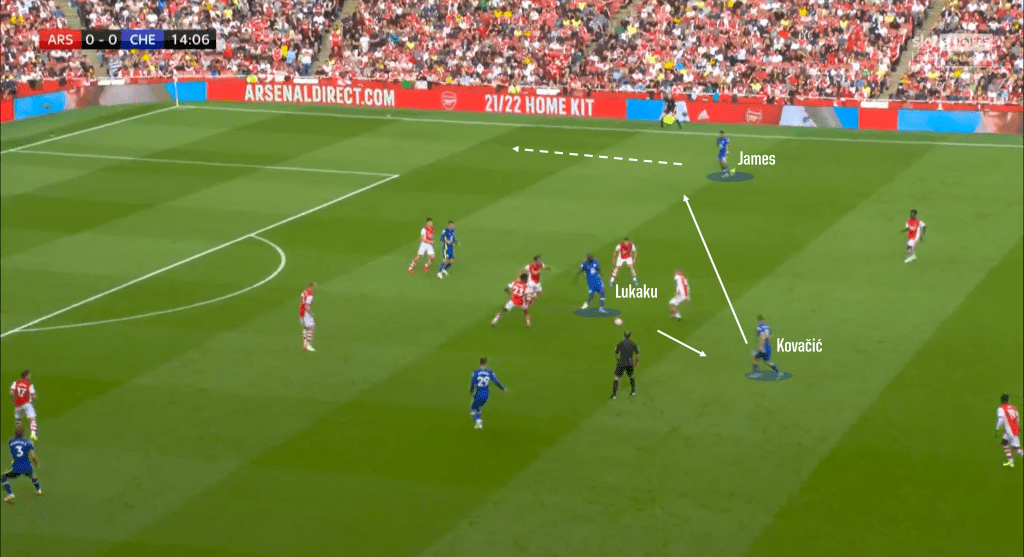
Lukaku then turns and runs in behind into the space that Marí has vacated, easily shrugging off the chasing defender and tapping in the cross.
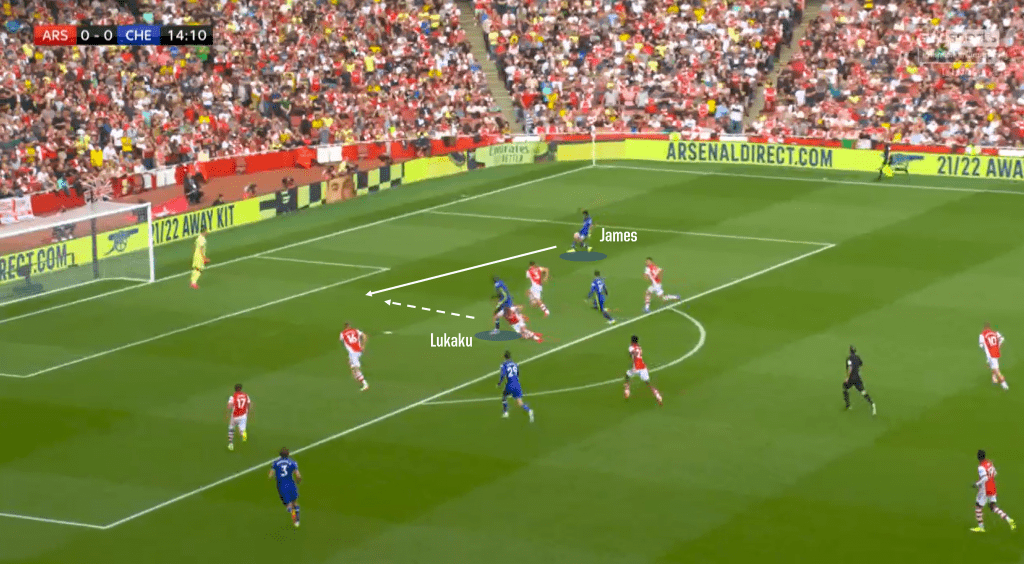
Ok, so don’t get too tight then? Easy.
But if you drop off too deep then you just let Chelsea progress the ball upfield with consummate ease. Here Marí drops way off and Lukaku has all the time in the world to gather, turn and bring teammates into play.
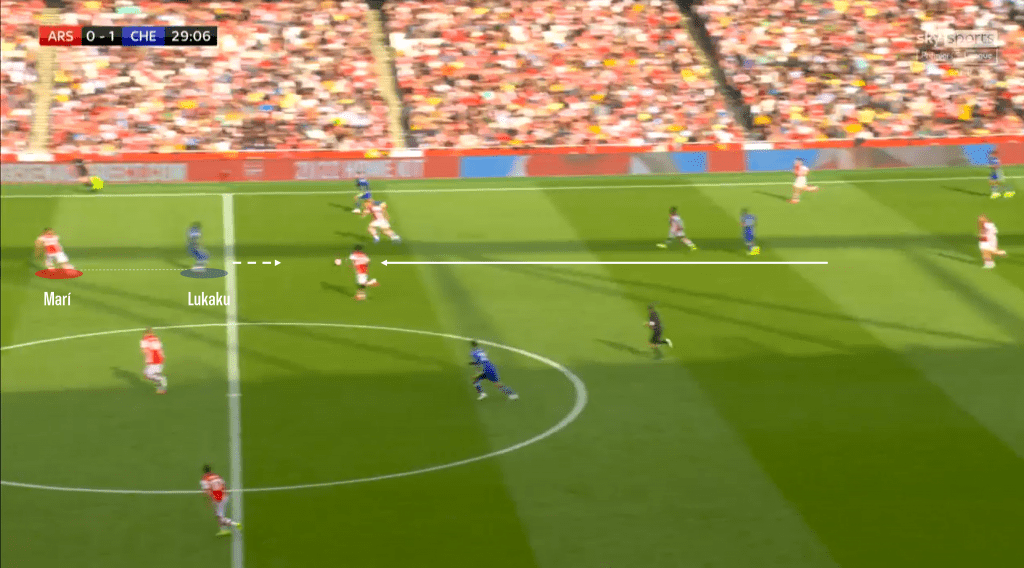
So, what do you do? Well, interestingly in that masterclass above with Jamie Carragher, and in this segment with Wolves defender Conor Coady, both centre backs talk about ‘trying to get away’ from Lukaku. It’s almost as if the striker wants to mark them, rather than the other way around. So rather than getting too tight, or dropping off too much, both talked about stepping off slightly, but keeping the striker at arm’s length, content to force him back into a mesh of holding midfielders or be ready to nip in on any loose touch.
Sounds good in principle. But it’s easier said than done. Because Lukaku knows that’s what you’re trying to do.
To illustrate this point, we’ll fast forward to the 70th minute. Jorginho picks the ball up and rolls it into Lukaku’s feet. The striker’s got a big forearm out and is backing into Marí, initiating contact and creating that ‘pin’ by holding Marí in place.
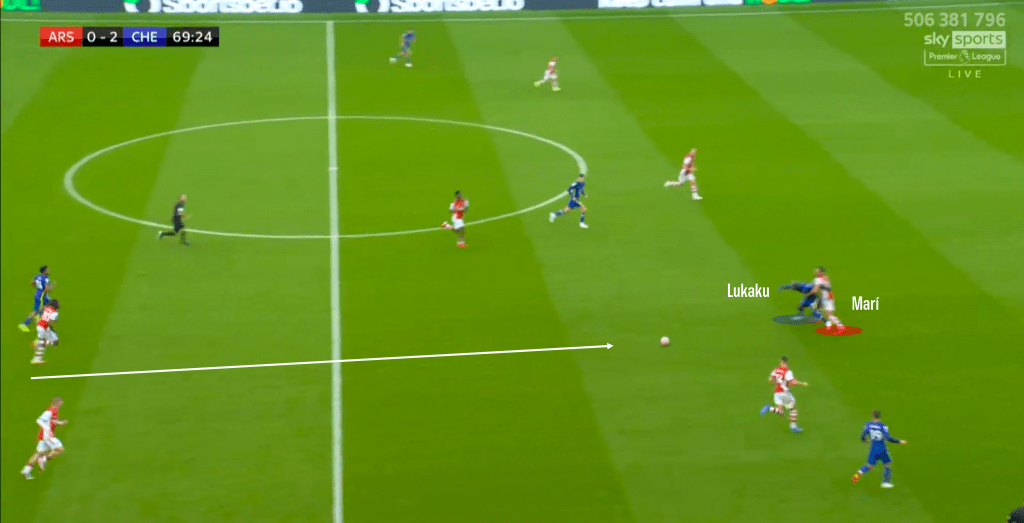
He receives the ball on his left foot and Marí mistakenly tries to nip round Lukaku’s left side to pinch the ball. But from the body angles, there’s just no way that’s feasible. You can tell from this freeze frame that Lukaku’s got him already.
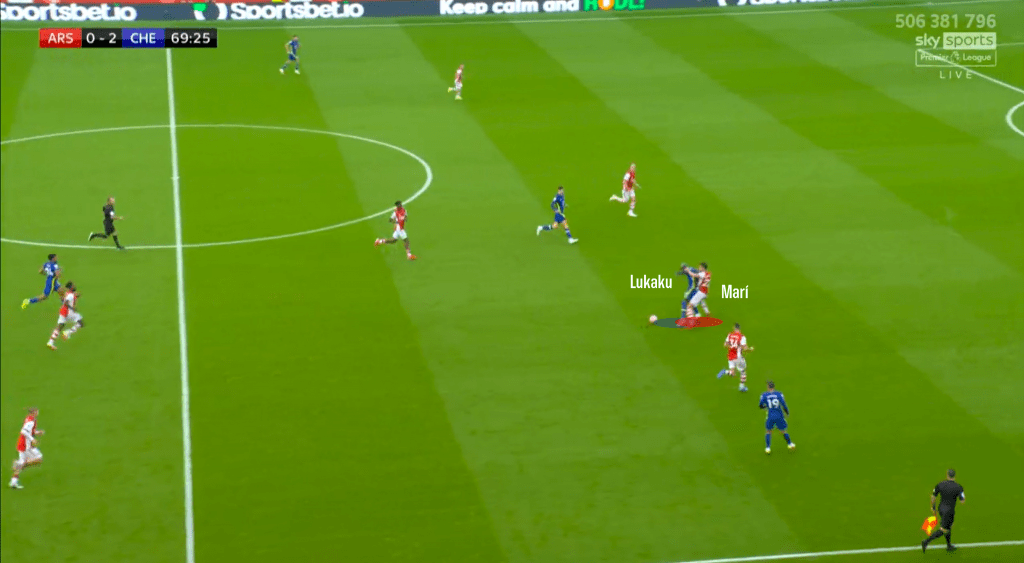
Next, he rolls him. Just as he spoke about four years ago. And Chelsea are motoring once again.
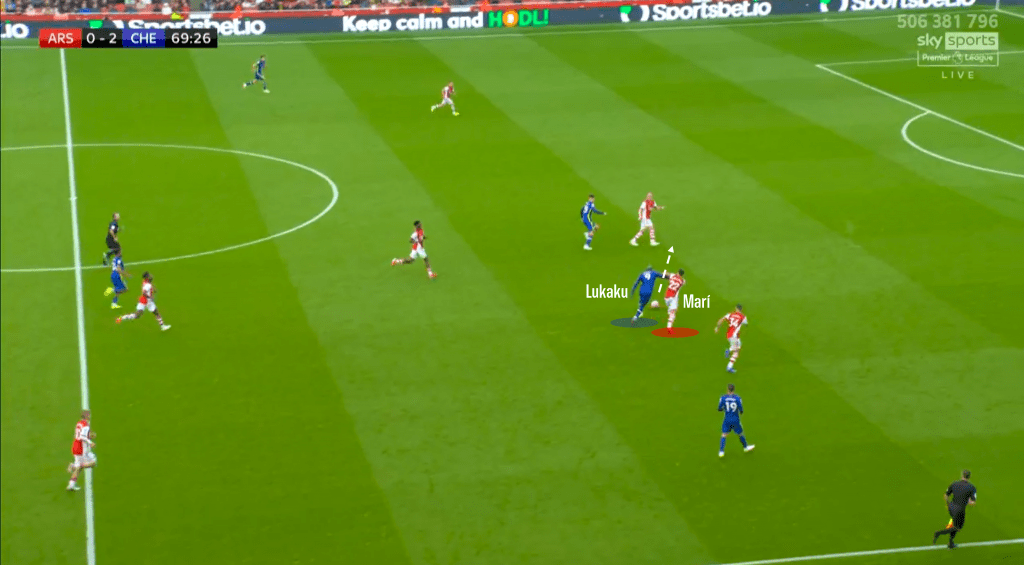
So… what do you do?!
You ask for help.
2. The Need for a Midfield Screen
There was a lot of talk after the game about Mikel Arteta’s decision to play a back four against Chelsea, rather than matching them up with a back five.
That said, Xhaka regularly dropped between Marí and Kieran Tierney to form a back five, as can be seen from this early freeze frame. Presumably, that decision was either to offer Marí some support against Lukaku or allow Tierney to focus his attention on James.
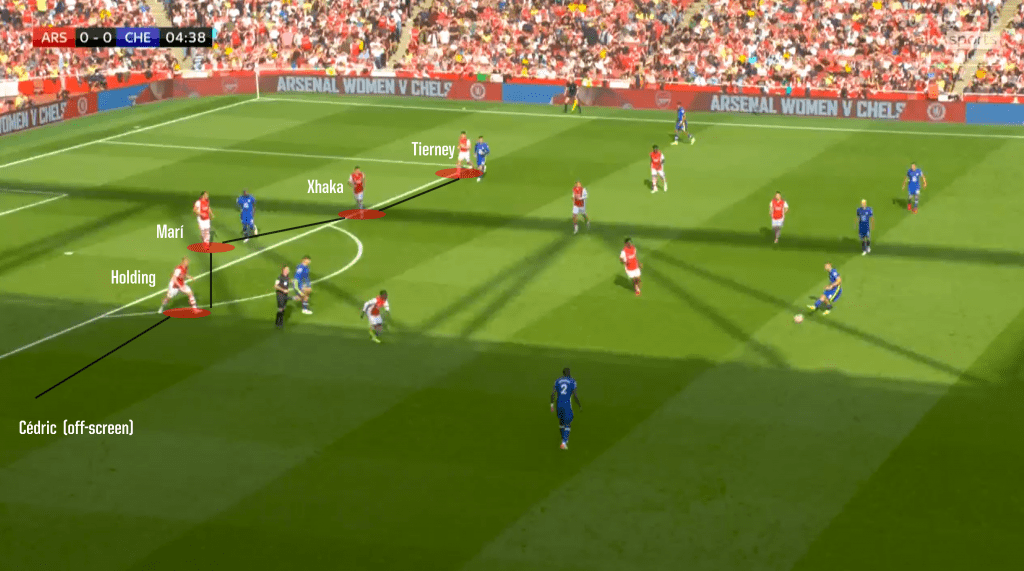
Unfortunately for the Gunners, neither of those things really happened.
Instead, Xhaka’s positioning meant Arsenal didn’t have an effective midfield screen to block the entry pass into Lukaku’s feet. It was the case for the opening goal but it happened far sooner than that in the below attack four minutes in. Note Xhaka in the back line and the lack of a player blocking the passing lane to Lukaku. Kovačić has a simple ball into Lukaku’s feet.
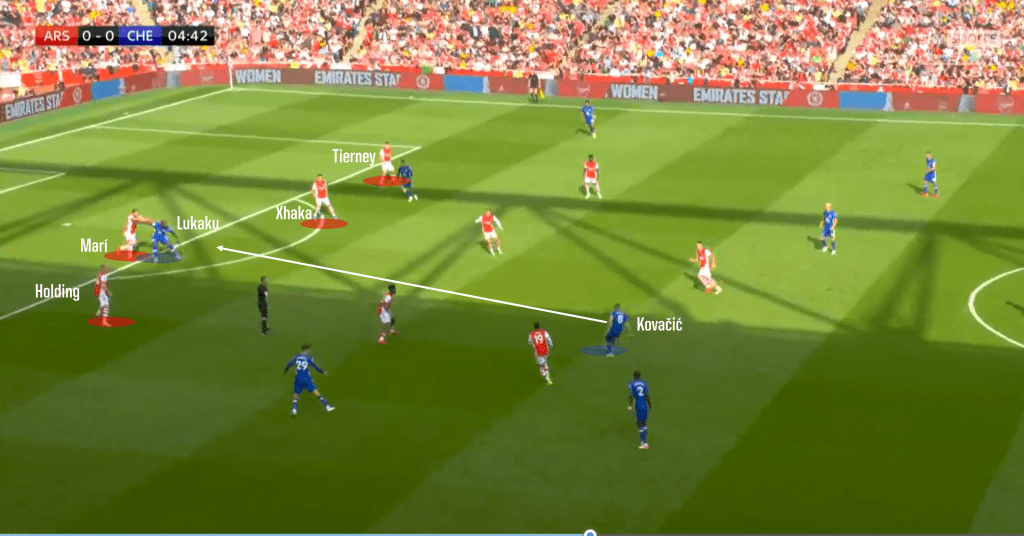
Lukaku was able to easily hold up the ball before bringing Havertz into play who got off a shot.
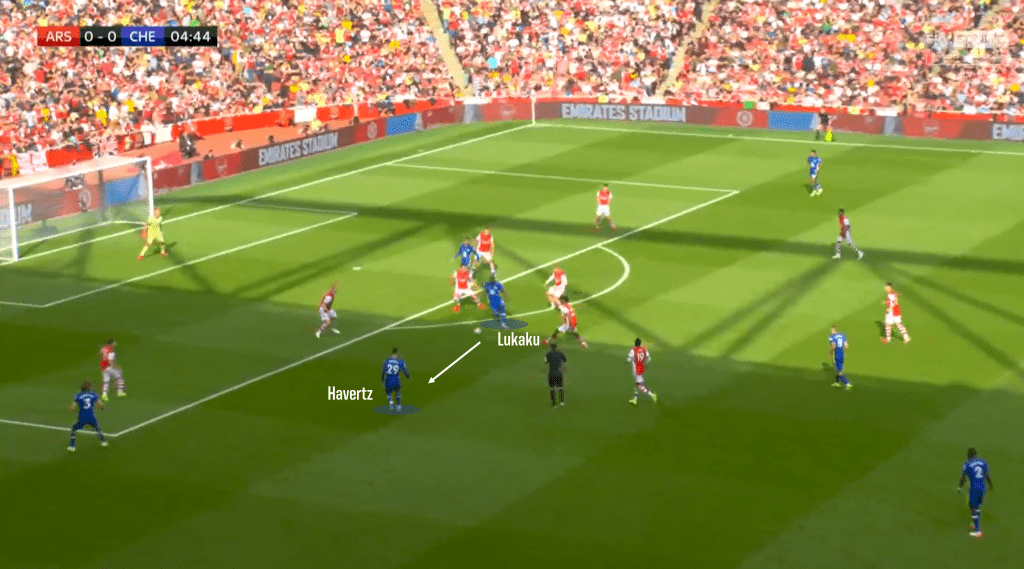
The Arsenal midfield players needed to play like a box, right in front of the two centre backs, blocking the supply line into Chelsea’s front men. Even if the ball does get into Lukaku, if they are close to the centre backs, they are closer to disrupt play.
This happened constantly throughout the game. In fact, passes to Lukaku bypassed 117 Arsenal players in total on Sunday. That’s the second highest number of players beaten with passes this season in one game, behind Gabriel Jesus (128) against Norwich. That demonstrates just how much Chelsea were able to beat Arsenal’s midfield with passes to him.
In this clash, Liverpool’s holding midfielder, whether that be Jordan Henderson or Fabinho, will aim to block those passing lanes into Lukaku, to stop those slicing passes from Chelsea’s midfielders. Other teams might look to put two or even three midfield players in the way to block the supply line.
But then that raises a question about how you cover Chelsea’s width…
3. Liverpool Must Be Wary of Chelsea’s Width
Ahead of the Champions League final, Pep Guardiola sat down with BT Sport to discuss the match. One of the most fascinating things to come out of it was a segment on Chelsea’s tactics.
“They have three central defenders close and two holding midfielders close… and the distances [between them] are so close. Then, at the same time, they are so wide with the wing backs and have so much depth [with the forwards]”.
He’s right, of course. As part of Stats Perform’s sequences and possessions data, we can look at the average width of a team when in possession. Here are the top five ‘widest’ teams so far.
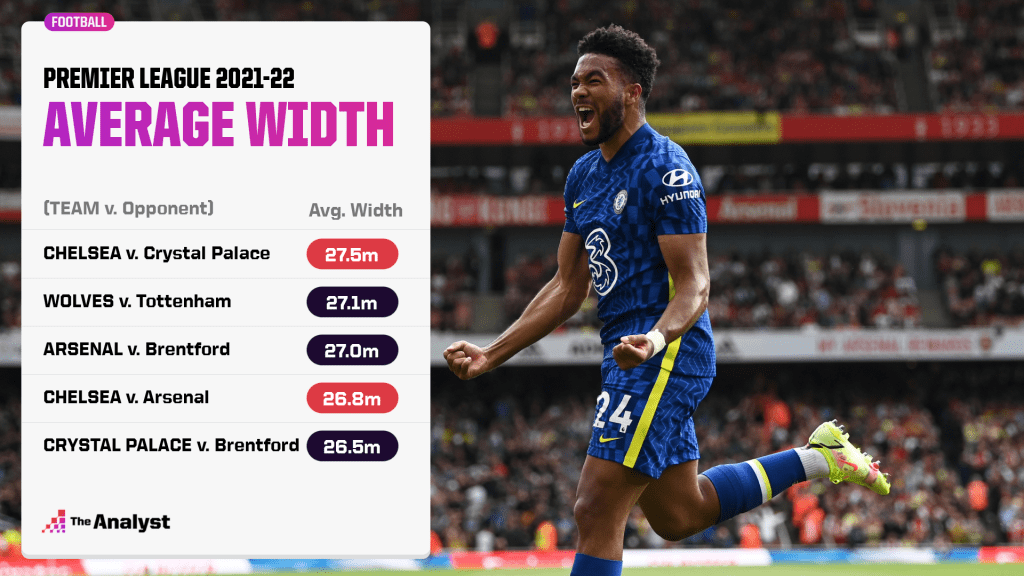
Chelsea’s two matches so far have seen them offer so much width via their attacking wing backs. The width and advanced position of their wing backs is something we highlighted in last week’s Blueprint as well.
The intricate passing patterns of Jorginho and Kovačić, together with the close distances between them and their three central defenders, bunches the opposition inwards to congest play. This leaves space on the flanks for the wing backs to fly into.
This happened for the first goal. As mentioned before, Lukaku receives the ball into feet and holds off Marí. He attracts three more Arsenal players towards him, and Tierney – Arsenal’s left back – is sucked in to deal with Mount.
That leaves so much room for Reece James, who receives the ball from Kovavic, to exploit the numerical overload.
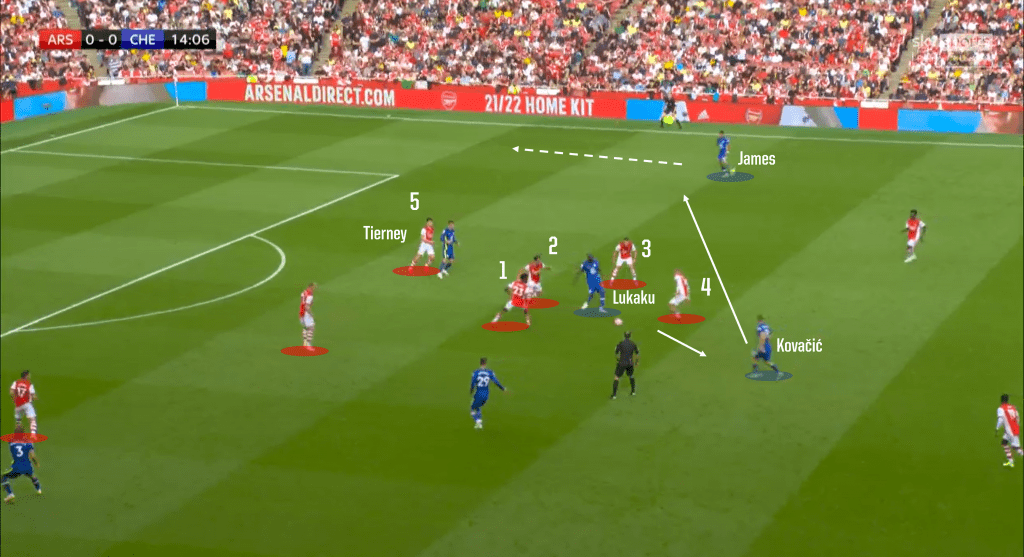
James then crosses for Lukaku to tap in.
Liverpool will need to balance blocking service into Chelsea’s No. 9 while keeping an eye on their advanced wing backs.
Which brings us onto…
4. The Battle of the Full Backs
As well as Lukaku, James was another standout performer for Chelsea at the weekend as he constantly exploited the space afforded to him by Arsenal’s narrow shape. As we outlined in our post-match blog, James posed his highest ever figures in a Premier League game for expected assists (0.8), shots (four) and touches in the opposition box (nine), with an assist for Lukaku’s opener and scoring the second goal himself.
In addition to his four shots, the England international created four chances for his teammates, meaning he had a hand in over a third of Chelsea’s 22 shots in the match (36%).
Not to be outdone by his rival for the right-back spot in Gareth Southgate’s team, Trent Alexander-Arnold was also at his creative best against Burnley. The English full back assisted Sadio Mané’s goal to seal the victory. This was one of seven chances he created in the game – equalling his highest-ever tally in a Premier League match and the highest of any player in these rounds of fixtures. Like James, he also registered his highest ever expected assist total in a single game (1.1).
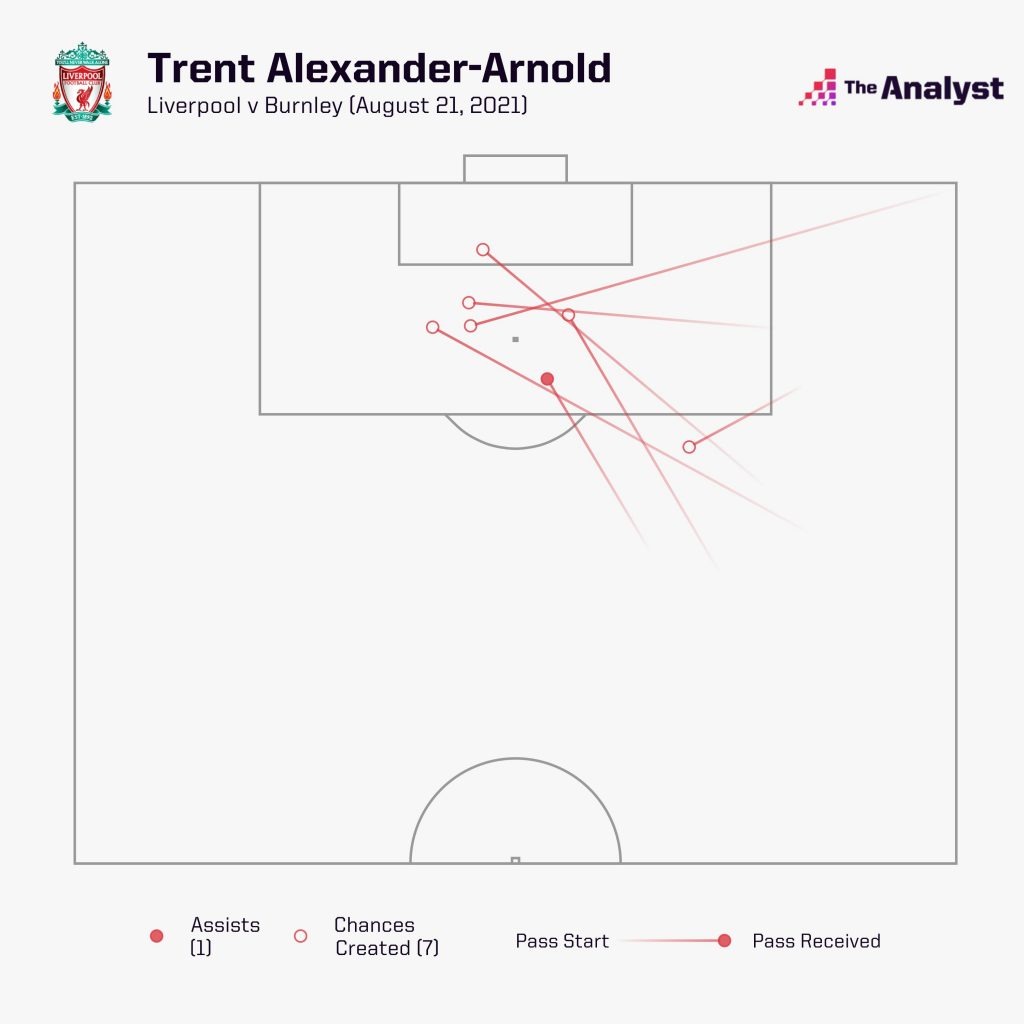
Alexander-Arnold has been back to his best in Liverpool’s two opening games. His passing has been typically incisive: on average he’s bypassed just over 2.5 opponents per pass. That’s the sixth-highest figure in the league to date and when you consider three of those players are defenders at Burnley (who naturally bypass plenty of opponents through long, direct balls), we can appreciate the impact of the full back’s passing range.
With Andy Robertson set to return at left back after his ankle injury, and Alonso enjoying a renaissance under Tuchel, expect both sides to lean heavily on their attacking full backs for chance creation.
5. Van Dijk’s Passing Range Can Undo the Chelsea Press
It’s hard to articulate just how important Virgil van Dijk is to this Liverpool team, so we’ll let the numbers do that. In their win over Burnley at the weekend, he made his 48th home Premier League appearance with Liverpool, and so far, he’s not lost a single game (W43 D5). Only Lee Sharpe has played more home games for one club in the competition without losing any of them (59 with Manchester United). The equation for Liverpool is simple. Plug van Dijk in and we won’t lose.
The prospect of him going up against Lukaku is tantalising. If there’s one defender in the league that will fancy his chances against Lukaku one-on-one then it’s van Dijk. He’ll back himself to match Lukaku physically, or even step in front of him knowing he has the recovery pace to deal with the striker spinning in behind.
But what van Dijk also brings is incredible passing range. If we narrow down all passes in the Premier League this season to progressive passes – i.e those that move the ball 25% closer to the opposition goal – then only Luke Ayling has made more progressive passes than van Dijk among centre backs.
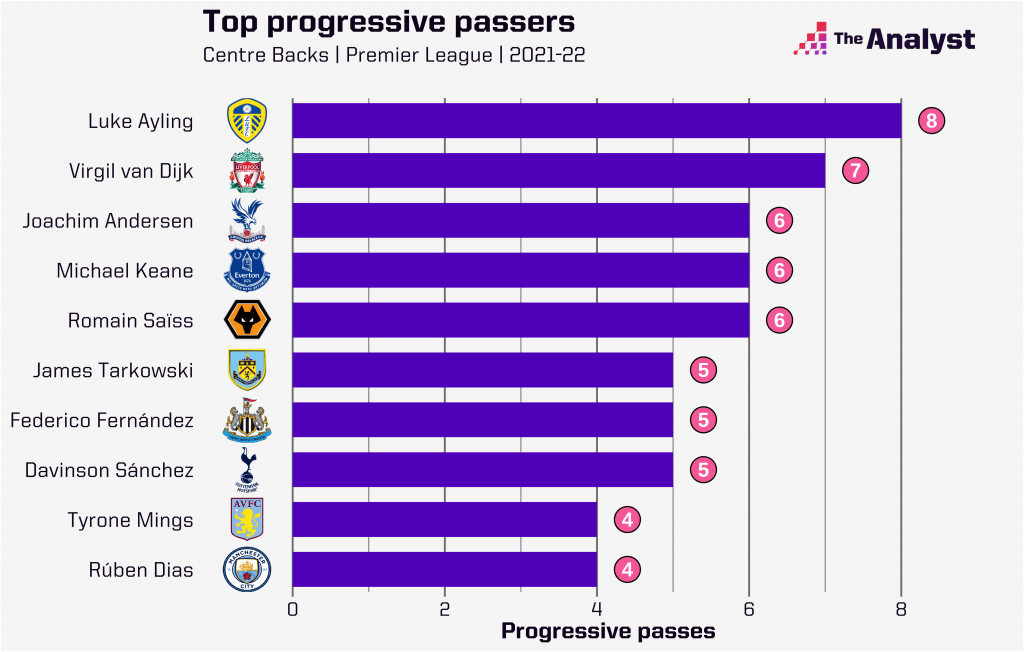
This is hardly surprising. Looking back to 2019-20, van Dijk’s last full season, and we see that he ranked third for progressive passes among centre backs. Conor Coady, aka Wolves quarterback, was first.
A lot of van Dijk’s progressive passing comes via switches of play, where he’s able to get his wide players isolated one on one vs. opposition full backs or centre backs. His progressive pass map below shows his frightening range of passing.
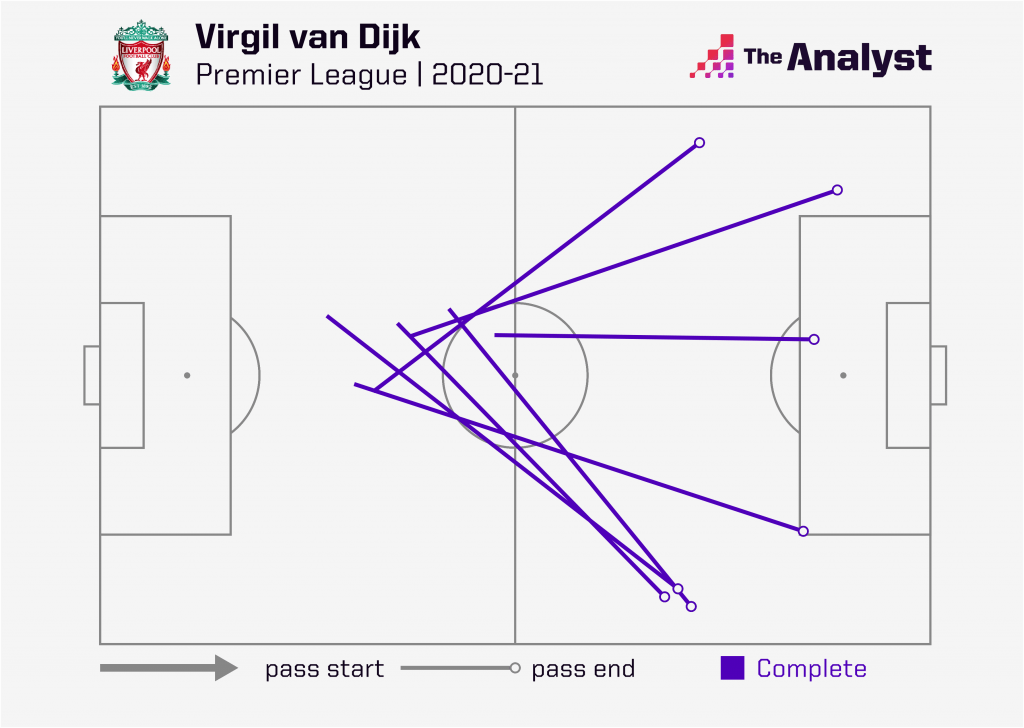
As well as being able to launch Liverpool attacks, his passing is also good enough to beat an opponent’s press.
After suffering defeat against Liverpool at Anfield last season, Arteta articulated this well.
“They keep going, they have bodies, they have quality,” Arteta said. “You put them under pressure with a perfect high press and van Dijk hits an 80-yard ball to Salah’s chest. This is quality and that’s why they paid £80million for this guy.”
That’s exactly what the Dutchman did in the build-up to Mané’s goal at the weekend, with an effortless switch to Harvey Elliot. It looks like something that van Dijk has actively worked on too, completing 47% of his progressive pass attempts this season compared to 36% in 2019-20.
We know Chelsea like to press under Tuchel. With a 8.9 PPDA, only Leeds United have pressed more aggressively this season. But with van Dijk able to go over their press, that may be a lot less effective this weekend.
Enjoy this? Subscribe to receive weekly Analyst content
Design by Matt Sisneros.
